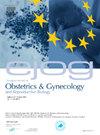Prevalence of term prelabor rupture of membranes and factors associated with a longer interval of rupture: data from the 2021 French national perinatal survey
IF 2.1
4区 医学
Q2 OBSTETRICS & GYNECOLOGY
European journal of obstetrics, gynecology, and reproductive biology
Pub Date : 2025-03-18
DOI:10.1016/j.ejogrb.2025.03.036
引用次数: 0
Abstract
Objectives
Term prelabor rupture of membranes (term PROM) increases maternal and neonatal morbidity, but its current prevalence is unknown. This study aimed to estimate the prevalence of term PROM and to identify factors associated with a longer interval of rupture of membranes using recent national population-based data.
Study design
Women with singleton pregnancies and term deliveries from the 2021 French National Perinatal Survey were selected. The prevalence of term PROM, defined as the rupture of membranes from 37 weeks before spontaneous labor, and its 95 % confidence interval (CI) were estimated. The median interval of rupture, defined as the time between the rupture of membranes and the onset of spontaneous labor, induction or prelabor caesarean (whichever occurred first) was calculated. Sociodemographic and pregnancy factors related to a longer interval of rupture of membranes were analyzed using a survival analysis, adjusting for competitive risks of a spontaneous labor: induction of labor and prelabor cesarean. Adjusted Hazard Ratios (aHR) were calculated using multivariate analysis.
Results
Among 10,810 eligible women, 3,052 had a term PROM, yielding a prevalence of 28.2 % (95 %CI 27.4–29.1). The median interval of rupture was 8.3 h (Interquartile 25–75[3.5–21.3]). Within the first 24 h following PROM, 90 % of women with a spontaneous labor were in labor. Factors associated with a longer interval of rupture included maternal age ≥35 (aHR = 0.82 95 %CI 0.72–0.93), primiparity (aHR = 0.73 95 %CI 0.66–0.81), Body-mass Index ≥25 (aHR = 0.87 95 %CI 0.77–0.97) or ≥30 (aHR = 0.73 95 %CI 0.62–0.85), being single (aHR = 0.66 95 %CI 0.48–0.90) and lower education (aHR = 0.82 95 %CI 0.69–0.97).
Conclusions
Term PROM affects more than one in four women. Sociodemographic factors and parity are associated with a longer interval of rupture.
求助全文
约1分钟内获得全文
求助全文
来源期刊
CiteScore
4.60
自引率
3.80%
发文量
898
审稿时长
8.3 weeks
期刊介绍:
The European Journal of Obstetrics & Gynecology and Reproductive Biology is the leading general clinical journal covering the continent. It publishes peer reviewed original research articles, as well as a wide range of news, book reviews, biographical, historical and educational articles and a lively correspondence section. Fields covered include obstetrics, prenatal diagnosis, maternal-fetal medicine, perinatology, general gynecology, gynecologic oncology, uro-gynecology, reproductive medicine, infertility, reproductive endocrinology, sexual medicine and reproductive ethics. The European Journal of Obstetrics & Gynecology and Reproductive Biology provides a forum for scientific and clinical professional communication in obstetrics and gynecology throughout Europe and the world.

 求助内容:
求助内容: 应助结果提醒方式:
应助结果提醒方式:


